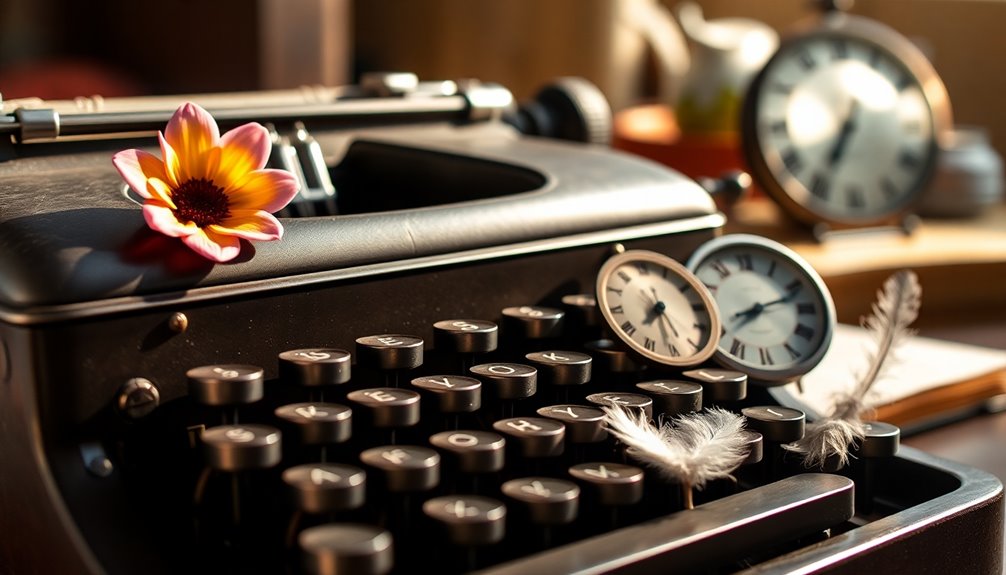Authors use symbolism to make stories more exciting and meaningful! By turning objects, characters, or events into symbols, they can express big ideas in a way that's easy to understand. This helps you connect with the story and its characters on a deeper level. For instance, a single red rose might symbolize love or passion. These symbols also encourage you to think about the themes, like hope or loss, throughout the tale. If you pay attention, you'll find clues that reveal deeper meanings. It's like a treasure hunt in the story, and there's so much more to discover!
Key Takeaways
- Authors use symbolism to convey complex themes and emotions succinctly, enhancing the depth of their narratives.
- Symbolism fosters emotional connections between readers and characters, making stories more impactful and relatable.
- Recurring symbols create motifs that reinforce key themes, inviting deeper analysis and interpretation of the text.
- Effective symbolism captures personal journeys and transformations, enriching character development throughout the story.
- Cultural context influences the interpretation of symbols, allowing authors to communicate intended meanings effectively.
Understanding Symbolism

In literature, symbolism serves as a powerful tool that authors wield to convey complex ideas and emotions. When you read a story, you might notice certain objects, characters, or events that stand for bigger concepts. This use of symbolism helps you understand deeper meanings hidden in the text. It's like a treasure hunt for emotions and thoughts!
Authors embed symbols to enhance thematic exploration. For example, a character might carry a specific object that represents hope or fear. By recognizing these symbols, you can connect with the characters on a more personal level. You'll find that these symbols often evoke emotional responses, making the story feel more real and engaging.
Understanding symbolism requires you to read closely and think critically. This means paying attention to the details and considering how cultural context shapes the symbols. Sometimes, a symbol might have different meanings based on the story's setting or the characters' backgrounds.
As you plunge into the world of symbolism, you'll find it enriches your interpretation of the text. It transforms reading into an exciting adventure, where you're not just following a story, but exploring the layers of meaning within it!
Importance of Symbolism in Writing

Symbolism in writing is super important because it helps you feel the story on a deeper level.
When authors use symbols, they can share big ideas and emotions without needing many words, making it more exciting for you as a reader.
Plus, symbols can spark your imagination, encouraging you to think about what they really mean as you explore the story!
Enhancing Emotional Resonance
Crafting a narrative that resonates emotionally often hinges on the subtle art of symbolism. When authors use symbols in literature, they reveal a powerful tool for emotional engagement. Through these symbols, you can uncover deeper meanings and connect with complex emotions that might otherwise go unexpressed.
Here are three ways symbolism enhances emotional resonance:
- Evokes Personal Connections: Symbols can relate to your own experiences, making the story feel more personal and impactful.
- Creates Motifs: The strategic use of symbols can form motifs that reinforce key themes, adding layers to the narrative.
- Facilitates Non-Verbal Communication: By conveying feelings through symbols, authors allow you to connect with characters and situations without needing explicit explanations.
When you encounter a simple object or action that transforms into a powerful emotional trigger, it enriches your storytelling experience. These symbols invite you to explore your interpretations, deepening your connection to the story.
In this way, symbolism serves as a bridge, leading you from surface-level understanding to profound emotional experiences within the narrative. Embrace the magic of symbolism, and let it guide your journey through the pages!
Conveying Complex Themes
While exploring a narrative, you often encounter symbols that distill complex themes into accessible ideas, allowing you to engage with deeper meanings effortlessly. Authors use symbols to convey big ideas like love, loss, and morality in ways that are easy to understand. Instead of lengthy explanations, they can show you what these themes mean through clever imagery.
When you read literature, you might notice how certain objects or actions become powerful symbols. For example, a withering flower might represent lost love, while a bright sun could symbolize hope.
These symbols create recurring motifs that tie the story together, making it feel more cohesive.
Engaging Reader Interpretation
How do symbols deepen your understanding of a story? Symbols play a crucial role in engaging you as a reader. They invite you to dig deeper into the narrative, encouraging you to interpret the themes and meanings behind the characters and events.
Here's how symbolism enhances your reading experience:
- Creates emotional connections: Symbols help you feel more connected to characters and their journeys, making their struggles and triumphs resonate with you.
- Encourages personal interpretation: You can derive your own meanings from the symbols, which makes the story feel more personal and exciting.
- Reinforces themes: Recurring symbols act as motifs, guiding you through the narrative and highlighting important messages.
When authors use symbolism, they enrich the story without overwhelming you with lengthy explanations. Instead, they present complex ideas in a simple way. This keeps your interest alive and sparks your curiosity.
By recognizing patterns and symbols, you become an active participant in the story. You're not just reading; you're interpreting and engaging with the text.
Identifying Symbols in Literature

In literature, symbols serve as powerful tools that deepen your understanding of a story. When you read, you might notice that certain objects, colors, or even natural elements pop up repeatedly. These symbols might help convey complex ideas and emotions, making the story richer.
For example, think about the green light in "The Great Gatsby." It symbolizes unattainable dreams, showing how authors use symbolism to highlight bigger themes in society and personal desires.
To identify symbols, pay close attention to the context of the story. Sometimes, a symbol can have different meanings, depending on the cultural background and experiences of the author and reader. This is why reading carefully is so important!
As you explore, you'll find that symbols can create emotional responses and enhance your connection to the characters and their journeys.
Look for examples of symbolism in literature, like recurring motifs, which signal important themes. By doing this, you'll not only enjoy the story more but also uncover layers of meaning that make the reading experience even more exciting!
Types of Symbolism

Symbolism comes in various forms, each offering unique ways to convey deeper meanings in literature. Understanding the types of symbolism can enhance your reading experience and help you appreciate the layers of meaning in stories. Here are some key types of symbolism:
- Metaphor: A direct comparison that helps explain complex ideas, like saying "Time is a thief."
- Color symbolism: Colors evoke emotions or themes, such as black for death and white for purity.
- Object symbolism: Tangible items carry deeper meanings, like a rose symbolizing romance.
Another fascinating type is allegories, which use entire narratives to symbolize broader concepts, like George Orwell's "Animal Farm."
Seasonal symbolism is also important, where seasons represent different life stages, like spring for new beginnings or winter for endings.
By recognizing these types of symbolism, you can reveal richer interpretations of the text.
Each type, from color symbolism to object symbolism, serves as a powerful literary device.
Cultural Context and Interpretation

When exploring literature, recognizing the cultural context behind symbols enriches your understanding of the narrative. Symbols often carry layers of meaning that connect deeply to societal values. For instance, a tree might symbolize strength in one culture while representing knowledge in another. This variation shows how cultural context influences interpretation.
When you grasp the cultural significance of symbols, you uncover the author's intended message. It helps you see how they reflect the issues or values of their time. This connection not only heightens the narrative impact but also boosts your engagement with the text. You might find that a symbol resonates with you because of your own experiences or background. Symbols like the Philosopher's Stone can illustrate profound transformations that relate to personal journeys.
Authors carefully choose symbols that relate to their audience's cultural understanding. This guarantees that the symbolism is effective and relatable, helping you avoid misinterpretation. Additionally, understanding common dream symbols can provide insight into how authors utilize symbolism to convey deeper emotional truths.
When you appreciate these elements, the story comes alive in exciting ways. You feel more connected to the characters and the themes they explore.
Symbolism in Poetry vs. Prose

When you read poetry, you'll notice how symbols pop up quickly, packing a lot of meaning into just a few lines.
In contrast, prose lets symbols grow and change over time, creating motifs that help shape the whole story.
Both forms use symbolism to spark feelings, but they do it in their own special ways!
Brevity in Poetry
Poetry packs a powerful punch with its concise use of symbolism, allowing poets to express complex ideas in just a few words. This brevity gives poetry a unique edge over prose.
You'll find that poetic symbols often stand alone, leading to rich emotional impact and vibrant imagery. Each image invites you to dive deeper and discover various interpretations.
Here are three reasons why brevity in poetry is so special:
- Strong Imagery: Poets use fresh symbols that create striking pictures in your mind.
- Emotional Impact: With fewer words, each symbol resonates more deeply, sparking strong feelings.
- Open Interpretations: Without extensive context, you get to explore meanings based on your own insights.
Unlike prose, where symbols can develop into larger motifs, poetry often captures themes in a snapshot. This means every word counts, and every symbol holds weight.
The beauty of poetry lies in its ability to convey so much with so little. So, next time you read a poem, pay attention to those symbols! They're tiny treasures packed with complex ideas, waiting for you to uncover their meanings. Enjoy the journey!
Motifs in Prose
In the world of prose, motifs emerge as powerful symbols that recur throughout a narrative, enriching the story's themes and character arcs. These repeated symbols help you dive deeper into the meaning of the text. Unlike poetry, where symbols must fit into a tight space, prose gives you room to explore their significance over time.
Here's a quick look at how motifs function in prose:
| Prose | Poetry |
|---|---|
| Develops over longer text | Needs concise imagery |
| Rich context for symbols | Immediate, impactful symbols |
| Highlights character growth | Evokes emotions quickly |
| Invites deeper analysis | Focuses on brevity |
In your writing, using motifs can guide readers through character development and plot progression. Think of "The Great Gatsby"—its symbols, like the green light, highlight Gatsby's dreams and the American Dream. By incorporating motifs, you create layers of meaning that invite your readers to connect with the themes. So, don't shy away from using symbolism in your writing; it can make your stories truly come alive!
Practical Tips for Writers

Symbolism enriches storytelling, providing layers of meaning that can captivate readers. When you're ready to weave symbolism into your writing, start by focusing on your story's core theme. This will help you choose symbols that enhance your message and resonate deeply with your audience.
Here are some practical tips to keep in mind:
- Use concrete imagery and recognizable objects to create symbols that foster emotional connections.
- Consider cultural context to guarantee your symbols convey the intended meaning and avoid confusion.
- Allow your symbols to evolve naturally within your plot for richer storytelling.
Also, think about placement. Instead of being too obvious, try using understated symbolism. This approach engages readers more effectively and invites personal interpretation.
When readers discover meaning on their own, it makes the experience even more special!
Resources for Writers

As a writer, you'll find that having access to the right resources can greatly deepen your understanding of symbolism and enhance your storytelling. There are many exciting options available! Taking targeted courses, like those offered by Writers.com, can help you learn about imagery and symbolism in both poetry and prose. Additionally, understanding the importance of quality content creation can help you effectively convey symbolism in your writing.
Engaging in community workshops is another fantastic way to grow. They allow you to receive constructive feedback on your use of symbolism, creating a fun and collaborative environment. Furthermore, exploring essential oils for aromatherapy can enhance your writing environment, helping to inspire creativity and focus. Incorporating carrier oils into your writing space can also provide a calming atmosphere, further boosting your concentration.
Plus, writing prompts from various resources can inspire you to practice incorporating symbolism into your stories effectively.
Don't forget about newsletters! Subscribing to these keeps you informed about new techniques and tips related to symbolism and writing, perfect for authors enthusiastic to improve.
Lastly, tools like AutoCrit can be invaluable. They help refine your work by offering suggestions for improving your use of symbolism and overall writing quality.
Additionally, consider exploring content clustering strategies that can help you organize your ideas and enhance your storytelling techniques.
With these resources for writers, you'll be on your way to crafting stories that resonate deeply with your readers. So, plunge into, explore, and let your creativity flourish!
Frequently Asked Questions
Why Do Authors Use Symbolism in Their Stories?
Authors use symbolism in their stories to make ideas come alive! When you read, symbols help you understand deeper meanings without too many words.
They can show feelings, like love or sadness, through simple images. You might notice a repeated symbol, which can tie the whole story together, making it more exciting.
Plus, symbols let you interpret the story in your own way, sparking fun discussions with friends about what they really mean!
What Is the Purpose of Symbolization?
Symbolization adds a splash of color to stories!
When you immerse yourself in a book, you'll find symbols that represent deeper ideas. They help you connect with the characters and themes on a personal level.
For instance, a simple object might reveal feelings about love or friendship. By using symbols, writers make their stories richer and more exciting.
What Is the Purpose of Symbolism?
Symbolism adds a special touch to stories! It helps you discover deeper meanings without the author saying everything outright.
For example, when you see a dove, it might represent peace. Symbols make you think and feel more connected to the characters and themes.
They can also link ideas throughout the story, creating a richer experience. So, when you spot a symbol, get excited! It's a clue to what the author wants you to explore.
What Effect Does Symbolism Have on the Audience?
Imagine walking through a garden filled with colorful flowers, each one telling a different story.
That's how symbolism affects you as a reader! It helps you connect with the deeper themes of a story, like love or friendship.
When you spot a symbol, it sparks your imagination and invites you to explore the meaning behind it.
You don't just read; you feel and think, making the story come alive in your mind!
Conclusion
In the world of stories, symbolism is like a treasure map. It helps you uncover deeper meanings and connect with the characters. As you read, look for hidden gems that add sparkle to the tale. When you write, don't be afraid to sprinkle your own symbols throughout your work. They can make your stories come alive! Remember, every symbol tells a story of its own, guiding readers on a wonderful adventure filled with imagination. Happy writing!











